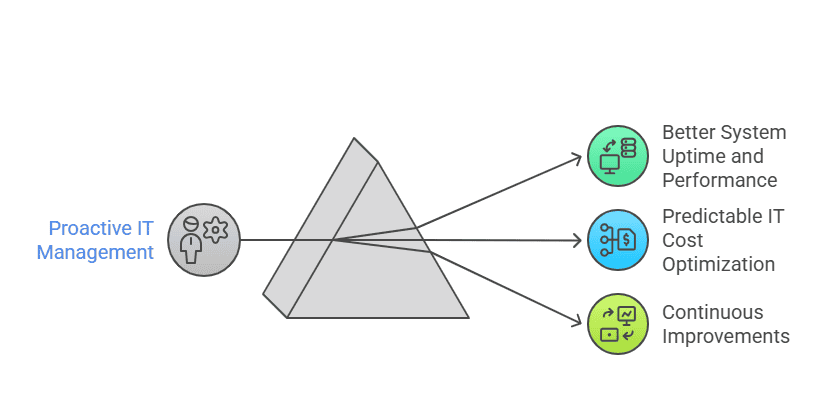Emergency I.T. repairs are costing businesses more than they realize. According to Gartner, downtime costs enterprises up to $9,000 per minute— this figure clearly shows how expensive last-minute fixes can get.
Many companies still rely on the break-fix approach, fixing problems only after they happen. This leads to lost productivity, frustrated employees, and damaged customer trust.
Charles Bender, CEO of Attentus Technologies, says, “Investing in proactive I.T. management isn’t just about avoiding problems. It’s about building a reliable system that supports business growth.”
This blog will explain why proactive I.T. management is smarter than emergency repairs. If you are a decision-maker or I.T. lead, you will learn how I.T. preventive measures improve your systems and reduce costs.
You will also find practical steps to create an effective I.T. maintenance plan that fits your business needs.
Stop Paying for I.T. EmergenciesSwitch to a proactive I.T. plan and cut downtime costs before your next system failure happens. |
What Happens When You Delay I.T. Preventive Measures
Many businesses fall into a break-fix culture because it seems cheaper upfront. You fix only when something breaks, hoping it won’t happen often.
However, this approach has hidden risks that cost more in the long run.
Failing to implement I.T. preventive measures leads to:
More downtime: When systems fail unexpectedly, your team stops working. Customers get frustrated. Productivity drops sharply.
Higher repair costs: Emergency fixes often need urgent help, expensive parts, or outside experts. This drives up your I.T. budget unpredictably.
Reduced system reliability: Regular care keeps systems stable. Without it, frequent breakdowns affect your entire operation.
Damage to reputation: When customer-facing systems fail, trust takes a hit, potentially leading to lost business.
The consequences of delaying preventive actions add up. It also makes your I.T. environment unpredictable, which makes planning for future growth harder. This leads us to why preventive I.T. strategies offer more stable results.
The Long-Term Value of Preventive I.T. Strategies
Switching from break-fix to preventive care is a shift toward control and stability. Preventive strategies focus on spotting issues early and stopping them before they become costly emergencies.
Here’s what preventive strategies bring to the table:
Lower risk of failure: Scheduled checks catch problems early. You fix them before they cause bigger damage.
Stable budget: A fixed I.T. maintenance plan means you pay predictable fees. This prevents surprise expenses from emergency repairs.
Extended equipment life: Regular care keeps hardware and software running longer, saving you money on replacements.
Improved IT system reliability and performance: Your systems work better, more consistently.
Per the US Department of Energy, preventive maintenance enhances reliability, improves safety, and cuts costs by 12–18% versus reactive maintenance. This means putting time and effort into IT preventive measures pays off with lower overall spending.
How Proactive I.T. Improves I.T. Operational Efficiency
When you act before problems arise, your entire I.T. operation runs smoother. Proactive I.T. means looking after systems continuously instead of waiting for trouble.
The benefits include:
- Smoother workflows: Systems with fewer interruptions let employees work efficiently. They waste less time fixing issues.
- Stronger system performance: Preventive updates and fixes keep your IT running at peak speed and reliability.
- Lower long-term costs: You avoid expensive emergency repairs and reduce downtime costs.
To achieve these benefits, focus on ongoing network monitoring and regular maintenance. This approach helps maintain I.T. operational efficiency so you can focus on business goals instead of firefighting IT problems.
I.T. Preventive Measures That Pay Off Fast
Several specific I.T. preventive measures show quick returns and improve your I.T. environment immediately:
- Scheduled hardware inspections: Regular checks identify wear or damage before it causes failures.
- Firmware and software updates: Updates fix bugs, patch vulnerabilities, and improve performance.
- Network monitoring and real-time alerts: Constant network watching catches problems early, allowing quick fixes.
- Use of AI and automation: These technologies support continuous IT improvement by predicting issues and automating routine tasks.
Each of these actions adds layers of protection. Together, they build a system that runs reliably and requires fewer emergency fixes.
When Reactive Maintenance Might Still Make Sense
There are times when reactive maintenance, or break-fix, still works. These cases are exceptions, not the rule:
- Limited-use assets: Equipment used rarely and not critical can be fixed as needed.
- Near end-of-life hardware: When devices are old and close to replacement, fixing them temporarily might save money.
- Low-impact failures: Systems that don’t affect core operations might be candidates for reactive fixes.
These exceptions are short-term solutions. Relying on reactive fixes beyond this leads to unstable I.T. and unpredictable costs.
| Explore More Cybersecurity Guides: |
How to Build a Practical I.T. Maintenance Plan
Creating a reliable I.T. maintenance plan takes clear steps. The plan balances routine care with cost control:
- Combine time-based and condition-based maintenance: Schedule regular checkups, but also monitor real-time system health.
- Assign responsibilities: Clarify who handles what, internal staff or managed service providers.
- Automate where possible: Use tools to handle updates, alerts, and routine tasks to reduce human error.
- Budget for continuous improvement: Include funds to upgrade systems and adopt new preventive IT strategies.
A well-designed plan improves your I.T. system reliability while managing costs and resource use effectively.
Why Proactive I.T. Is a Long-Term Strategy, Not a One-Time Fix

Proactive I.T. management is about steady, ongoing care. It’s not a quick fix for one problem but a commitment to long-term health.
This approach delivers:
- Better system uptime and performance
- Predictable I.T. cost optimization
- Continuous improvements to meet evolving business needs
By focusing on I.T. preventive measures, you support stable operations and reduce the risk of costly interruptions. Review your current IT policies regularly and commit to long-term, continuous IT improvement for the best results.
Common I.T. Maintenance Approaches Compared
Maintaining your I.T. environment involves different methods. The following table shows how common maintenance types compare across cost, reliability, and business impact.
| Maintenance Type | Cost Predictability | Impact on Reliability | Business Impact |
| Reactive (Break-Fix) | Unpredictable | Low | High downtime risk |
| Time-Based Preventive | Predictable | Moderate to High | Reduced downtime |
| Condition-Based Monitoring | Predictable | High | Minimal disruptions |
| Automated & AI-Driven | Predictable | Very High | Near-zero unplanned issues |
Choosing the right mix depends on your business size, I.T. complexity, and budget. Combining time-based and condition-based approaches supported by automation often delivers the best balance.
Transform Your I.T. Workflow Today with Tailored Automation Solutions from Attentus Technologies
Proactive I.T. management offers clear advantages over emergency repairs. You reduce downtime, control costs, and keep systems reliable.
Adopting preventive I.T. strategies helps you improve IT operational efficiency and achieve I.T. cost optimization.
Attentus Technologies is a SOC 2 Type 2 certified MSP with over 20 years in I.T. and cybersecurity, helping businesses increase uptime through effective I.T. maintenance plans.
| Discover Our I.T. Consulting Services Around You | ||||||
| Seattle | Bellevue | Tacoma | Renton | Federal Way | Kirkland | Everett |
Contact us today to learn how you can start saving money and protecting your business with a practical, long-term I.T. care strategy. Schedule a consultation to take the first step toward reliable I.T.


